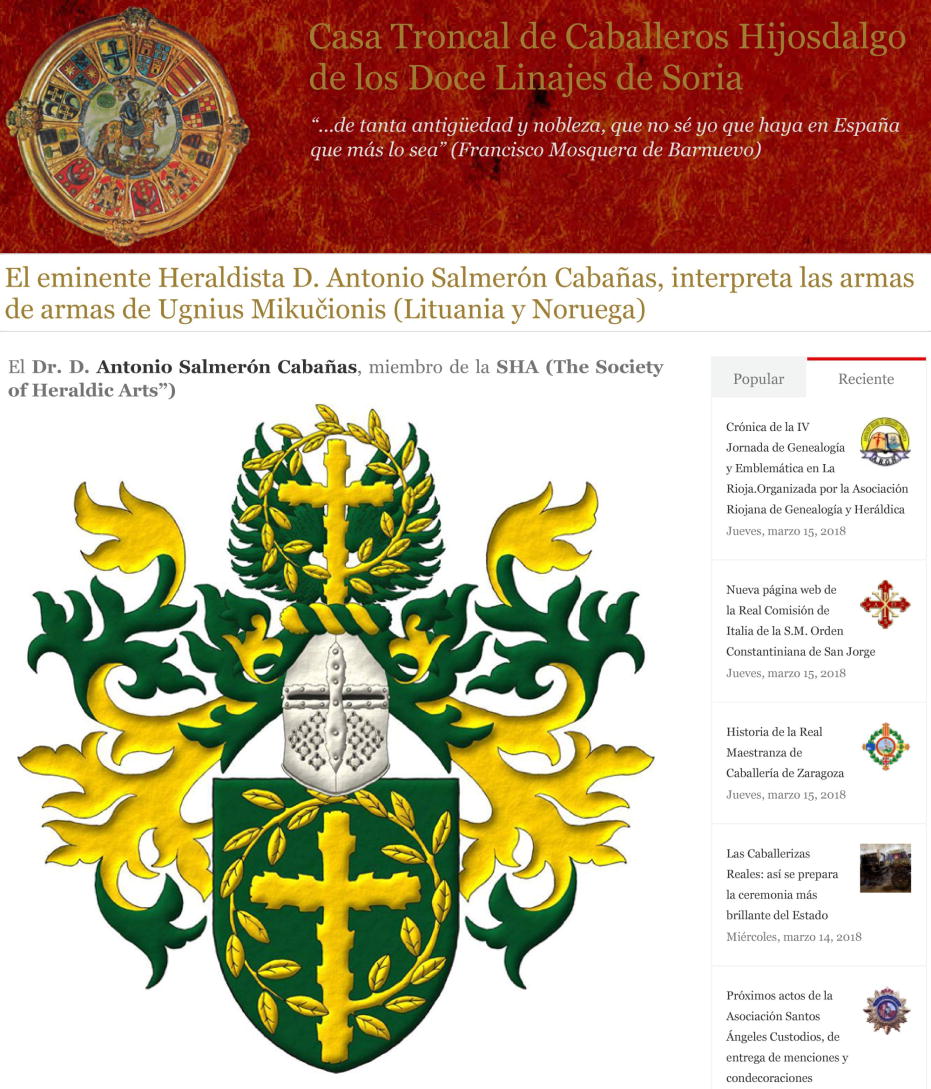At the nombril


![Ver [Coat of Arms of Ugnius Mikucionis in Twelve Lineages] en enlaces recomendados. Áncora de oro y la divisa enlace.](../css/Ancora.Enlace.png)
Coat of Arms of Ugnius Mikucionis in Twelve Lineages
Publication of my interpretation of the arms of Ugnius Mikucionis, on the blog Twelve Lineages of Soria with the article titled: The eminent heraldist Mr. Antonio Salmerón Cabañas interprets the coat of arms of Ugnius Mikucionis (Lithuania and Norway).
Blazon in Spanish by Alfonso de Ceballos-Escalera y Gila, Chronicler of Arms of Castile and León, from his certification of arms: «Vert, a Latin cross made of a wooden staff, raguly, from whose sinister flank issues a leafy branch that encircles the cross from above and entwines over its base, all Or. Crested with a steel helmet affronty, torse Or and Vert, with mantling Vert doubled Or. For crest, the same raguly Latin cross, branched and leafed, Or, placed before two wings Vert».
Blazon in English by The South African Bureau of Heraldry, from its certification of arms: «Vert, a wooden staff, its upper end terminating in a Latin cross, raguly, couped at random, issuant from its sinister nombril point a leaved offshoot encircling the cross, its end terminating and debruising the lower limb Or. Crest: In front of a pair of wings displayed Vert, a wooden staff issuant, its upper end terminating in a Latin cross, raguly, couped at random, issuant from its sinister nombril point a leaved offshoot encircling the cross, its end terminating and debruising the lower limb Or. Wreath and mantling: Vert and Or». I do not agree with the specification of the exact place of origin of the branch, the «nombril point» ~ «navel», because that point of origin does not distinguish this coat of arms from another where the branch could emerge at a different height, either closer or further from the point of the shield, and because it forces the artistic interpretation to either break the rule of fullness or to draw a curved branch in a panache shape to allow it to open before gaining height.
Note how in the Spanish certification of arms, by the Chronicler of Arms of Castile and León, this unnecessary nombril specification as the origin point of the branch is omitted.
The nombril is the exact crossing point of the vertical axis of symmetry of the shield with the lower edge of the bend.
Categories: Link, Vert, One, Cross, Raguly, Sinister, Or, Helm, Wreath, Mantling, Crest, Two, Wing and At the nombril.
Root: Twelve Lineages of Soria.


Full achievement of Alessandro Giannelli and Mariana von Atzingen Gorga
Party per pale: 1 Azure, on two swords in saltire Argent, hilted Or, an oil lamp (oleum lucerna) Or, its eyelet Argent, enflamed of three flames proper; 2 Gules, at the nombril, a barbel naiant Argent between in chief a fleur de lis Or, and in base a trimount Vert. Crest: Upon a helm, befitting the husband’s degree, with a wreath Or and Gules, an arm vambraced proper grasping a cross tau of olive wood in pale proper. Mantling: Gules doubled Or. Motto: «Fac maiora ne ulla facies».
Arms depicted by me, highlighted with lights and shadows, outlined in Sable, with a pointed external shape and with a freehand finishing.
G0093, Chief Herald of Arms of Malta's grant for the arms of Alessandro Giannelli and Mariana von Atzingen Gorga. These arms have been emblazoned by me for such grant.
Blazon keywords: Azure, Argent, Or, Gules, Vert, Two, One, Party per pale, Sword, In saltire, Hilted, Oil lamp, Enflamed, Flame, Proper, At the nombril, Barbel, Naiant, Between, In chief, Fleur de lis, In base, Trimount, Upon (wreath), Helm, Wreath, Arm vambraced, Grasping, Cross tau, In pale, Mantling, Doubled and Motto.
Style keywords: Outlined in sable, Illuminated, Pointed and Freehand.
Classification: Personal, Interpreted, Boa and Coat of arms.
Bearer: Giannelli and Mariana von Atzingen Gorga, Alessandro.


Giannelli and Mariana von Atzingen Gorga, Alessandro
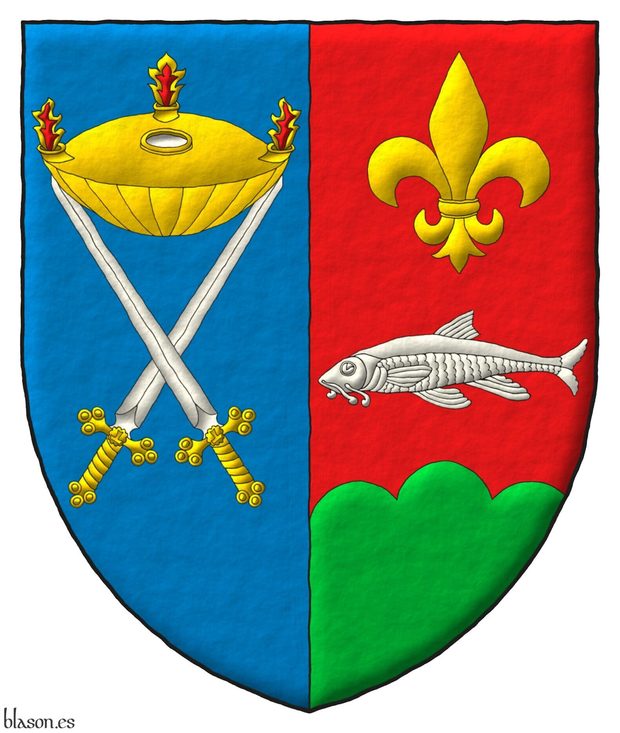
Party per pale: 1 Azure, on two swords in saltire Argent, hilted Or, an oil lamp (oleum lucerna) Or, its eyelet Argent, enflamed of three flames proper; 2 Gules, at the nombril, a barbel naiant Argent between in chief a fleur de lis Or, and in base a trimount Vert.
Escudo partido: 1o de azur, dos espadas en sotuer de plata, guarnecidas de oro sumadas de una lámpara de aceite (oleum lucerna) de oro, con su orificio de plata, encendida de tres llamas al natural; 2o de gules, en el ombligo, un barbo nadante de plata acompañado en jefe de una flor de lis de oro y en punta de un monte de tres peñas moviente de la punta de sinople.
Coat of arms painted by me, highlighted with lights and shadows, contoured in Sable, with a pointed outer contour and with a freehand finishing.
G0093, Chief Herald of Arms of Malta's grant for the coat of arms of Alessandro Giannelli and Mariana von Atzingen Gorga. This coat of arms has been emblazoned by me.
Blazon keywords: Azure, Argent, Or, Gules, Vert, Two, One, Party per pale, Sword, In saltire, Hilted, Oil lamp, Enflamed, Flame, Proper, At the nombril, Barbel, Naiant, Between, In chief, Fleur de lis, In base and Trimount.
Style keywords: Outlined in sable, Illuminated, Pointed and Freehand.
Classification: Personal, Interpreted, Boa and Coat of arms.
Bearer: Giannelli and Mariana von Atzingen Gorga, Alessandro.

Nhf, Norsk Heraldisk Forening
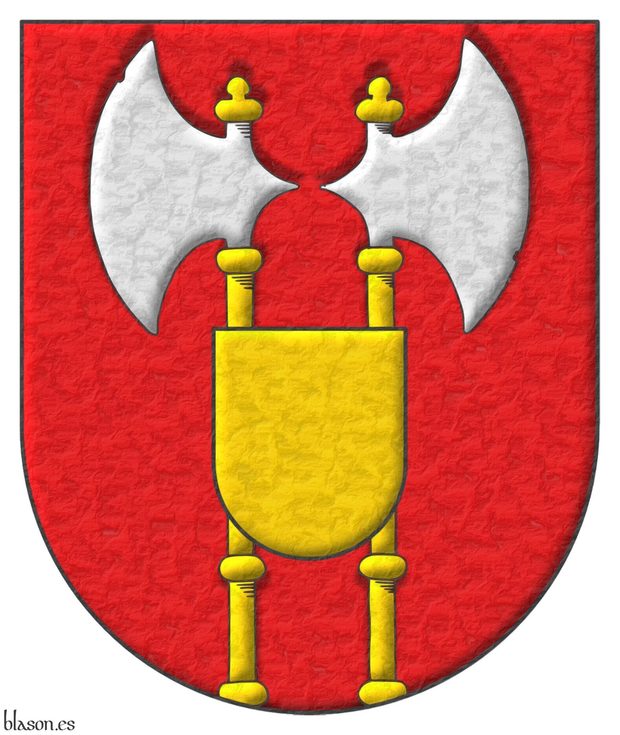
Gules, two Axes Argent, hafted Or, addorsed, issuant from the base; overall, at the nombril, an Escutcheon Or.
Escudo de gules, dos hachas adosadas de plata, fustadas de oro, movientes de la punta; brochante sobre el todo, en el ombligo, un escudete de oro.
Coat of arms interpreted with: the semicircular shape; its field illuminated with Gules; its figures and escutcheon illuminated with Or and Argent and outlined in Sable; and with a free hand texture.
At the nombril
A distinctive feature of this coat of arms is that its escutcheon, instead of being overall in the center, is positioned on a point of the coat of arms called the nombril, which, as we learn from [Avilés, J.; 1725a; page 159 and illustration 19] and also [Avilés, J.; 1780a; pages 147 and 148], in «Heraldry, the nombril of the coat of arms, is the place through which the human body receives nourishment in the mother's womb, and in the shield, it corresponds to the point where the fess ends and the base begins.».
If this escutcheon, «escudete» in Castilian, had been positioned in the center of the coat of arms, then it would have to be blazoned as the piece called an inescutcheon, «escusón» in Castilian. In fact, the Norsk Heraldisk Forening uses the English term «escutcheon» to describe the blazon of its arms.
Blazon keywords: Without divisions, Gules, Axe, Argent, Hafted, Or, Addorsed, Issuant from base, Overall, At the nombril and Escutcheon.
Style keywords: Semi-circular, Illuminated, Outlined in sable, Shaded and Soft metal.
Classification: Interpreted, Socioeconomic and Coat of arms.
Bearer: Norsk Heraldisk Forening.


![Ver [Norsk Heraldisk Forening] en instituciones citadas. Fortaleza de oro y mazonada de sable.](../css/Fortaleza.Institucion.png)
Norsk Heraldisk Forening
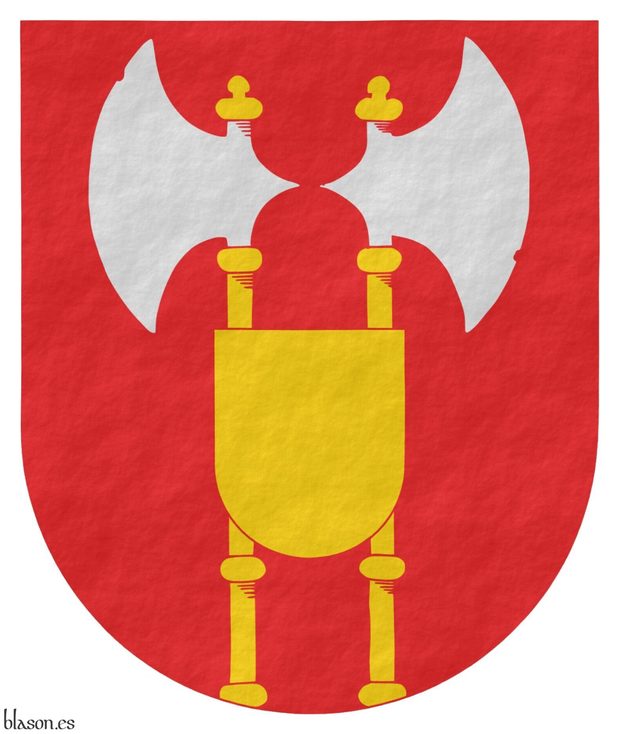
Norsk Heraldisk Forening, in English, Nordic Heraldry Society, was founded on February 27, 1969, at the National Archives in Oslo, with the aim of promoting the study and knowledge of heraldry through meetings, lectures, excursions, and other dissemination methods, and additionally, to become an advisory body to resolve issues in matters of heraldry, flags, personal coats of arms, etc. Its first president was Dr. Philos Herman L. Løvenskiold.
Since then, these have remained the objectives of the Norsk Heraldisk Forening, and its membership count has remained between 150 and 200 members, and it cooperates with the Nordic Heraldry Society, «Societas Heraldica Scandinavica».
The website's address is Heraldikk.no, its content is available in both Norwegian and English, and they work systematically to expand it and provide greater and better information to both its members and those interested in heraldry.
Blazon
Alex Maxwell Findlater described it in English, including its crest, in an article that was on their previous website under the title «About the society», as follows: «Gules issuant from base two battle-axes addorsed Argent shafted Or overall at the nombril point an escutcheon Or; for Crest between two axes of the arms a panache of three peacock feathers proper; Mantling Gules doubled Or». But given that «shafted» applies to weapons with a shaft and «hafted» to weapons with a handle, in the case of axes, I use «hafted» although both terms correspond to the Spanish «fustado».
Note how the axes are described as battle-axes, just as in the blazon of the Norwegian coat of arms, where its lion holds a battle-axe.
Coat of arms I attempted to interpret in the Norwegian style, all in flat tinctures, without Sable outlines, lighting or shading, and only with a simple rough finish.
Categories: Institution, Interpreted, Socioeconomic, Semi-circular, Plain tincture, Outlined in the field tincture, Rough, Coat of arms, Without divisions, Gules, Axe, Argent, Hafted, Or, Addorsed, Issuant from base, Overall, At the nombril and Escutcheon.


Norsk Heraldisk Forening, coat of arms
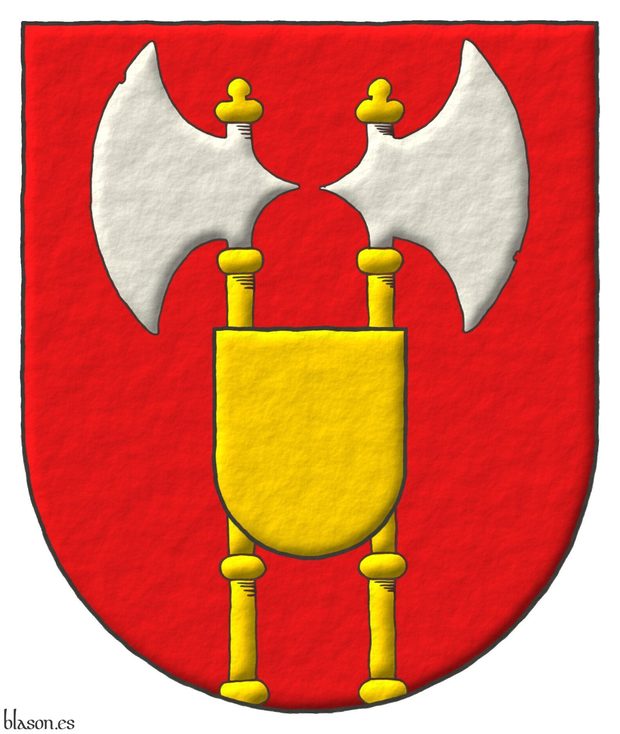
Gules, two axes addorsed Argent, hafted Or, issuant from the base; overall, at the nombril, an escutcheon Or.
Escudo de gules, dos hachas adosadas de plata, fustadas de oro, movientes de la punta; brochante sobre el todo, en el ombligo, un escudete de oro.
Interpretation I have made with the following characteristics: the escutcheon is semicircular, in the classic Castilian style; its field is illuminated with the tincture gules; its 2 axes and escutcheon are outlined in sable and illuminated with the metal Or, and the axe heads in Argent; and the execution is in a raised line style.
Hafted or shated
The term «hafted» in English is specifically used for weapons with handles, such as axes and hammers. This refers to the part of the weapon where the user grips, which is typically made of wood or metal and is essential for wielding the weapon effectively. The haft is integral to the weapon's function, providing the necessary leverage and control during use.
On the other hand, «shafted» is a term used in English for weapons with a shaft, which is a longer, slender part of the weapon, as seen in spears, arrows, and sometimes in lances. The shaft is usually the primary structural component, providing the length and reach, while also serving as the backbone of the weapon.
In both cases, the term indicates that this part of the weapon is of a different tincture from the rest of the figure.
In Castilian, however, both «hafted» and «shafted» translate to «fustadas», which broadly refers to a similar concept where the handle or shaft is of a different color than the head or blade.
Then, I prefer using «hafted» when referring to axes and hammers due to the specificity of the term in English.
This contrasts with the term «guarnezidas» ~ «hilted», which is used for swords, indicating a different color for the guard or hilt, rather than for the shaft or handle.
Addorsed, back to back
For the arrangement of the axes in relation to each other, the one on the dexter facing dexter, the one on the sinister facing sinister, I use the term «addorsed» as it is the most common, but I previously used «back to back», which is said of «two animals, rampant, with their backs against each other, each facing the opposite flank. Two keys are also described as back to back when they are positioned with the bits outward, each to its side; the same applies to sickles, or scythes and generally to all long objects that have two faces, like two axes...» [Avilés, J.; 1780a; page 98], this being the case for the axes in this shield.
«Dalla» is a synonym for «scythe» used in and originating from Aragon and Navarra, [Real Academia Española; 2001].
In the English blazon, «adosadas», «de espaldas», is rendered as «addorsed», from the French «adossé», which is said, for example, when «two animals turned back to back» and some also use «endorsed».
Blazon keywords: Without divisions, Gules, Axe, Argent, Hafted, Or, Addorsed, Issuant from base, Overall, At the nombril and Escutcheon.
Style keywords: Semi-circular, Illuminated, Outlined in sable and Freehand.
Classification: Interpreted, Socioeconomic and Coat of arms.
Bearer: Norsk Heraldisk Forening.
-
Language
-
Categories of heraldry
-
Divisions of the field
- Without divisions
- Party per pale
- Party per fess
- Party per bend
- Party per bend sinister
- Tierce
- Tierce sinister
- Tierced per pale
- Tierced per fess
- Tierced per bend
- Tierced pallwise inverted
- Quarterly
- Quarterly per saltire
- Gyronny
- Party per fess, the chief per pale
- Party per pale, the sinister per fess
- Party per fess, the base per pale
- Party per pale, the dexter per fess
- Chapé
- Chaussé
- Embrassé
- Contre-embrassé
- Party per chevron
- Enté
- Enté en point
- Flanched
-
Metals
-
Colours
-
Furs
-
Other tinctures
-
Ordinaries and sub-ordinaries
-
Diminutives of the ordinaries
-
Other charges
-
Charges from Nature
Water, Eagle, Bald eagle, Eagle claw, Dorsal fin, Tail fin, Two hands clasped, Lark, Tree, Trunk, Rainbow, Atom, Barbel, Acorn, Bighorn sheep, Arm, Owl, Vulture, Horse, Head, Goat, Camellia, Thistle, Merino ram, Kapok tree, Stag, Doe, Crescent, Increscent, Chrysanthemum, Tail, Tail addorsed, Ermine spot, Hummingbird, Snowflake, Heart, Roe deer, Neck, Stags' attires, Roe deers' attires, Raven, Dolphin, Diamond, Tooth, Elephant, Trunk (elephant), Beetle, Emerald, Starling, Mullet, Mullet of four points, Star of David, Estoile, Male figure, Fleur de lis, Flower, Cornflower, Dogwood flower, Lotus flower, Hop cone, Bluebonnet, Puffin, Ash, Rooster, Claw, Talon, Goose, Heron, Seagull, Pomegranate, Sunflower, Swallow-tail, Falcon, Leaf, Boar, Goldfinch, Laurel, Barn owl, Lion, Lioness, Lion passant, Leopard, Lion rampant guardant, Lynx, Lily, Madonna lily, Flame, Wolf, She-wolf, Parrot, Moon, Hand, Apple, Apple tree, Sea, Martlet, Wing, Two wings in vol, Covert, Blackbird, Mount, Trimount, Fly, Wrist, Elm, Olive tree, Orbital, Bear, Palm frond, Palm tree, Dove, Poplar leaf, Panther, Jaguar, Vine, Paw, Forepaw, Foot (palmiped), Foreleg, Peacock, Chest, Pelican, Pelican in her piety, Dog, Brach hound, Warren hound, Fish, Hoof, Beak, Feather, Ostrich feather, Cinquefoil, Quetzal, Branch, Sprig, Frog, Shamrock, Caboshed, Oak, Holm oak, Rose, Double rose, Savage, Serpent, Plough of Ursa Major, Sun, Sun in splendour, Ray of the sun, Lightning flash, River, Stem, Badger, Tyger, Linden, Wheat, Wheat spike, Bull, Tulip, Udder, Escallop and Fox.
-
Artificial charges
Halberd, Plough share, Ace of spades, Anchor, Cyclamor, Torch, Bow, Arch, Harp, Non-classic artifact, Winnowing fan, Crozier, Conductor's baton, Pair of scales, Ship, Oar, Sail, Norman ship, Beret, Grenade, Ecclesiastical cap, Arm vambraced, Knight, Chain, Cup, Covered cup, Monstrance, Bell, Bell tower, Cannon, Cannon dismounted, Cannon port, Carbuncle, Castle, Ribbon, Clarion, Nail, Crucible, Cord, Dagger, Key ward, Turret, With a turret, Armillary sphere, Sword, Federschwert, Sabre, Parchment, Scroll, Skirt, Arrow, Club, Garb, Sheaf of tobacco, Scythe, Gauntlet, Axe, Buckle, Galician granary, Host, Bonfire, Polish winged hussar, Church, Fanon, Oil lamp, Spear, Spear's head, Fleam, Letter, Book, Open book, Closed book, Bookmark, Page, Line, Lantern, Key, Four crescents joined millsailwise, Hammer, Two-handed sword, Menorah, Mortar, Pestle, Number, Knot, Celtic Trinity knot, Water-bouget, Comb, Piano, Millstone, Millrind, Millwheel, Quill, Clay pot, Potent, Bridge, Cuffed, Hourglass, Chess rooks, Compass rose, Rosette of acanthus leaves, Mullet of six points pierced, Broken, Portcullis, Wheel, Wagon-wheel, Symbol, Sackbut, Drum, Geometric solid, Tetrahedron, Tower, Trident, Trumpet, Double vajra and Anvil.
-
Immaterial charges
Angel, Archangel, Basilisk, Heart enflamed, Sacred Heart of Jesus, Paschal lamb, Dragon's head, Dragon, Wyvern, Phoenix, Garuda, Griffin, Sea-griffin, Winged hand, Our Lady of Mercy, Pegasus, Saint George, Mermaid, Trinity, Triton, Golden fleece, Unicorn and Ouroboros.
-
External elements
-
Heraldic creations
-
References
-
Formats
-
Keywords on this page
Between, Addorsed, Proper, Pointed, Azure, Barbel, Boa, Arm vambraced, Overall, Wreath, Upon (wreath), Crest, Cross, Outlined in sable, Two, At the nombril, In chief, In base, In saltire, Escutcheon, Coat of arms, Sword, Fleur de lis, Hafted, Personal, Giannelli and Mariana von Atzingen Gorga, Alessandro, Hilted, Gules, Axe, Illuminated, Interpreted, Mantling, Flame, Enflamed, Oil lamp, Semi-circular, Trimount, Issuant from base, Naiant, Norsk Heraldisk Forening, Or, Party per pale, Argent, Without divisions, Vert, Socioeconomic, Freehand, One and Helm.
